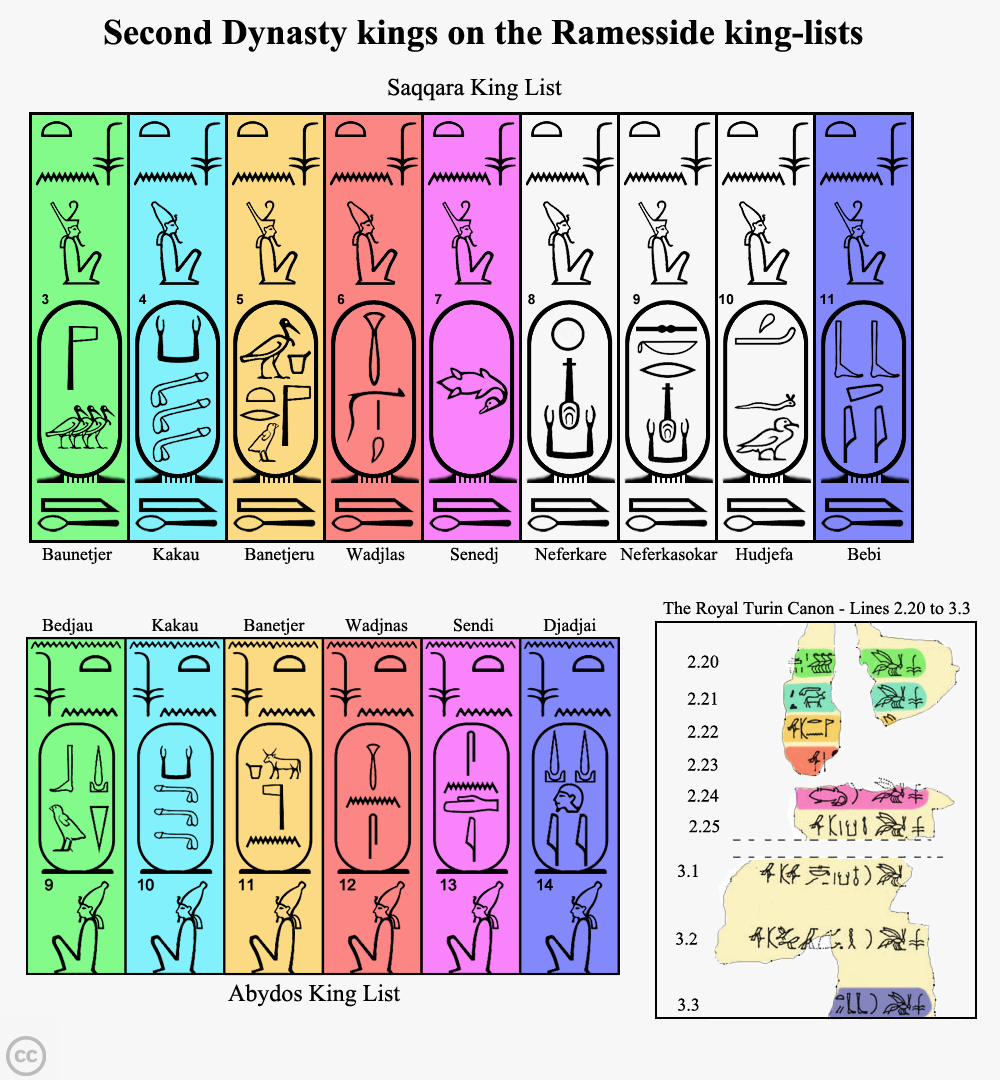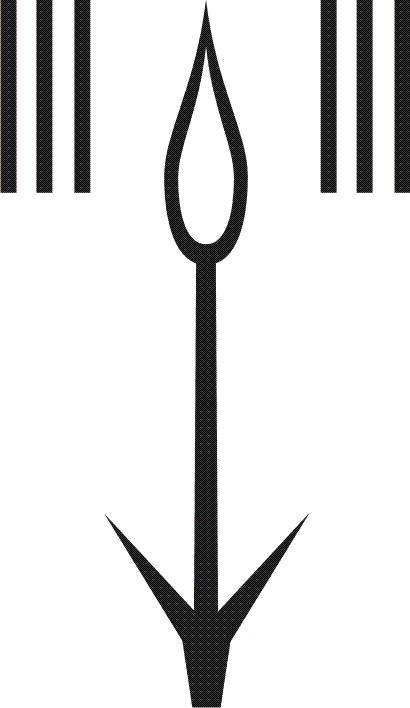|
Second Dynasty Of Egypt
The Second Dynasty of ancient Egypt (or Dynasty II, c. 2890 – c. 2686 BC) is the latter of the two dynasties of the Egyptian Archaic Period, when the seat of government was centred at Thinis. It is most known for its last ruler, Khasekhemwy, but is otherwise one of the most obscure periods in Egyptian history. Though archaeological evidence of the time is very scant, contrasting data from the First and Third Dynasties indicates important institutional and economic developments during the Second Dynasty. Rulers For the first three pharaohs, sources are fairly close in agreement and the order is supported by an inscription on the statuette of Hetepdief, who served in the mortuary cults of these three kings. But the identity of the next few rulers is unclear. Surviving sources might be giving the Horus name or the Nebty name and the birth names of these rulers. They may also be entirely different individuals, or could be legendary names. This might never be re ... [...More Info...] [...Related Items...] OR: [Wikipedia] [Google] [Baidu] |
Absolute Monarchy
Absolute monarchy (or Absolutism as a doctrine) is a form of monarchy in which the monarch rules in their own right or power. In an absolute monarchy, the king or queen is by no means limited and has absolute power, though a limited constitution may exist in some countries. These are often hereditary monarchies. On the other hand, in constitutional monarchies, in which the authority of the head of state is also bound or restricted by the constitution, a legislature, or unwritten customs, the king or queen is not the only one to decide, and their entourage also exercises power, mainly the prime minister. Absolute monarchy in Europe declined substantially following the French Revolution and World War I, both of which led to the popularization of theories of government based on the notion of popular sovereignty. Absolute monarchies include Brunei, Eswatini, Oman, Saudi Arabia, Vatican City, and the individual emirates composing the United Arab Emirates, which itself i ... [...More Info...] [...Related Items...] OR: [Wikipedia] [Google] [Baidu] |
Nynetjer
Nynetjer (also known as Ninetjer and Banetjer) is the Horus name of the third pharaoh of the Second Dynasty of Egypt. The length of his reign is unknown. The Turin Canon suggests an improbable reign of 96 years Alan H. Gardiner: ''The Royal Canon of Turin''. Griffith Institute of Oxford, Oxford (UK) 1997, ; page 15 & Table I. and Egyptian historian Manetho suggested that Nynetjer's reign lasted 47 years.William Gillian Waddell: ''Manetho (The Loeb Classical Library, Volume 350)''. Harvard University Press, Cambridge (Mass.) 2004 (Reprint), , page 37–41. Egyptologists question both statements as misinterpretations or exaggerations. They generally credit Nynetjer with a reign of either 43 years or 45 years. Their estimation is based on the reconstructions of the well known Palermo Stone inscription reporting the years 7–21, the Cairo Stone inscription reporting the years 36–44. According to different authors, Nynetjer ruled Egypt from c. 2850 BC to 2760 BC or later from c. 2 ... [...More Info...] [...Related Items...] OR: [Wikipedia] [Google] [Baidu] |
Abydos KL 02-05 N13 , in southwestern France
{{disambiguation, geo ...
Abydos may refer to: *Abydos, a progressive metal side project of German singer Andy Kuntz *Abydos (Hellespont), an ancient city in Mysia, Asia Minor * Abydos (''Stargate''), name of a fictional planet in the ''Stargate'' science fiction universe *Abydos, Egypt, a city in ancient Egypt * Abydos Station, a pastoral lease and cattle station in Western Australia See also *Abidu, a village in Iran *Abidos, Pyrénées-Atlantiques Abidos (; oc, Avidòs) is a commune in the Pyrénées-Atlantiques department in the Nouvelle-Aquitaine region in southwestern France. Geography Abidos is a Béarnais commune located some 13 km south-east of Orthez and 4 km north of M ... [...More Info...] [...Related Items...] OR: [Wikipedia] [Google] [Baidu] |
Senedj
Senedj (also known as Sened and Sethenes) was an early Egyptian king (pharaoh), who may have ruled during the 2nd Dynasty. His historical standing remains uncertain. His name is included in the kinglists of the Ramesside era, although it is written in different ways: While the Abydos King List imitates the archaic form, the Royal Canon of Turin and the Saqqara King List form the name with the hieroglyphic sign of a plucked goose. It is unknown how long Senedj ruled over Egypt. The Royal Canon of Turin credits him with 70 years of rulership, the ancient Egyptian historian Manetho states that ''Séthenes'' (as he calls Senedj) ruled for 41 years. Name sources The possibly only known contemporary inscription from Senedj's reign was found in 1909 by Egyptologist Uvo Hölscher, who assisted the excavations at the Khephren- and Menkaura temple at Giza. Hölscher found a small, thin-walled and polished diorite shard, which once belonged to a flat bowl. At the left breakline a ... [...More Info...] [...Related Items...] OR: [Wikipedia] [Google] [Baidu] |
Sekhemib-Perenmaat
Sekhemib-Perenma'at (or simply Sekhemib), is the Horus name of an early Egyptian king who ruled during the 2nd Dynasty. Similar to his predecessor, successor or co-ruler Seth-Peribsen, Sekhemib is contemporarily well attested in archaeological records, but he does not appear in any posthumous document. The exact length of his reign is unknown and his burial site has yet to be found. Name sources Sekhemib's name is known from seal impressions and from inscriptions on vessels made of alabaster and breccia. They were found in the entrance of Peribsen's tomb at Abydos, in the underground galleries beneath the step pyramid of (3rd Dynasty) king Djoser at Sakkara and on one excavation site at Elephantine.Toby A. H. Wilkinson: ''Early Dynastic Egypt''. Routledge, London und New York 1999, , page 90–91.William Matthew Flinders Petrie & Francis Llewellyn Griffith: ''The royal tombs of the first dynasty''. Volume II., Trübner & Co., London, 1900, page 7, 14, 19, 20 & 48.Pierr ... [...More Info...] [...Related Items...] OR: [Wikipedia] [Google] [Baidu] |
Lower Egypt
Lower Egypt ( ar, مصر السفلى '; ) is the northernmost region of Egypt, which consists of the fertile Nile Delta between Upper Egypt and the Mediterranean Sea, from El Aiyat, south of modern-day Cairo, and Dahshur. Historically, the Nile River split into seven branches of the delta in Lower Egypt. Lower Egypt was divided into nomes and began to advance as a civilization after 3600 BC. Today, it contains two major channels that flow through the delta of the Nile River – Mahmoudiyah Canal (ancient Agathos Daimon) and Muways Canal (, "waterway of Moses"). Name In Ancient Egyptian, Lower Egypt was as ''mḥw'' and means ''"north"''. Later on, during Antiquity and the Middle Ages, Greeks and Romans called it ''Κάτω Αἴγυπτος'' or ''Aegyptus Inferior'' both meaning "Lower Egypt", but Copts carried on using the old name related to the north – ''Tsakhet'' () or ''Psanemhit'' () meaning the "Northern part". It was further divided into number of re ... [...More Info...] [...Related Items...] OR: [Wikipedia] [Google] [Baidu] |
Saqqara Tablet
The Saqqara Tablet, now in the Egyptian Museum, is an ancient stone engraving surviving from the Ramesside Period of Egypt which features a list of pharaohs. It was found in 1861 in Saqqara, in the tomb of Tjuneroy (or Tjenry), an official ("chief lector priest" and "Overseer of Works on All Royal Monuments") of the pharaoh Ramesses II. The inscription lists fifty-eight kings, from Anedjib and Qa'a ( First Dynasty) to Ramesses II (Nineteenth Dynasty), in reverse chronological order, omitting "rulers from the Second Intermediate Period, the Hyksos, and those rulers... who had been close to the heretic Akhenaten". The names (each surrounded by a border known as a cartouche), of which only forty-seven survive, are badly damaged. As with other Egyptian king lists, the Saqqara Tablet omits certain kings and entire dynasties. The list counts backward from Ramesses II to the mid-point of the First Dynasty, except for the Eleventh and Twelfth Dynasties, which are reversed. A well known p ... [...More Info...] [...Related Items...] OR: [Wikipedia] [Google] [Baidu] |
Turin King List
The Turin King List, also known as the Turin Royal Canon, is an ancient Egyptian hieratic papyrus thought to date from the reign of Pharaoh Ramesses II, now in the Museo Egizio (Egyptian Museum) in Turin. The papyrus is the most extensive list available of kings compiled by the ancient Egyptians, and is the basis for most chronology before the reign of Ramesses II. Creation and use The papyrus is believed to date from the reign of Ramesses II, during the middle of the New Kingdom, or the 19th Dynasty. The beginning and ending of the list are now lost; there is no introduction, and the list does not continue after the 19th Dynasty. The composition may thus have occurred at any subsequent time, from the reign of Ramesses II to as late as the 20th Dynasty. The papyrus lists the names of rulers, the lengths of reigns in years, with months and days for some kings. In some cases they are grouped together by family, which corresponds approximately to the dynasties of Manetho's book. ... [...More Info...] [...Related Items...] OR: [Wikipedia] [Google] [Baidu] |
Abydos KL 02-04 N12 , in southwestern France
{{disambiguation, geo ...
Abydos may refer to: *Abydos, a progressive metal side project of German singer Andy Kuntz *Abydos (Hellespont), an ancient city in Mysia, Asia Minor * Abydos (''Stargate''), name of a fictional planet in the ''Stargate'' science fiction universe *Abydos, Egypt, a city in ancient Egypt * Abydos Station, a pastoral lease and cattle station in Western Australia See also *Abidu, a village in Iran *Abidos, Pyrénées-Atlantiques Abidos (; oc, Avidòs) is a commune in the Pyrénées-Atlantiques department in the Nouvelle-Aquitaine region in southwestern France. Geography Abidos is a Béarnais commune located some 13 km south-east of Orthez and 4 km north of M ... [...More Info...] [...Related Items...] OR: [Wikipedia] [Google] [Baidu] |
Wadjenes
Wadjenes (ancient Eyptian ''Wadj-nes'', which means "fresh of tongue"), also known as Wadjlas, Ougotlas and Tlas, was an early Egyptian king who may have ruled during the 2nd Dynasty. Since the name form "Wadjenes" is not contemporarily attested as the name of a king, but frequently appears in Ramesside kinglists, Egyptologists to this day are trying to connect Wadjenes with contemporary Horus-kings. Name sources The king's name "Wadjenes" is attested only in the Ramesside kinglists, where he is always presented as the immediate successor of king Nynetjer and as the predecessor of king Senedj. The same goes for the Royal Canon of Turin, where the entry for his name is damaged so only the years of rulership are preserved.Walter Bryan Emery: ''Ägypten. Geschichte und Kultur der Frühzeit.'' Fourier-Verlag, Wiesbaden 1964, , page 275. Whilst all kinglists match each other regarding the chronological position of Wadjenes, Egyptologists are uncertain as to the origin of the na ... [...More Info...] [...Related Items...] OR: [Wikipedia] [Google] [Baidu] |
Weneg (pharaoh)
Weneg (or Uneg), also known as Weneg-Nebty, is the throne name of an early Egyptian king, who ruled during the Second Dynasty. Although his chronological position is clear to Egyptologists, it is unclear for how long King Weneg ruled. It is also unclear as to which of the archaeologically identified Horus-kings corresponds to Weneg. Name sources and contradictions The name "Weneg" is generally accepted to be a ''nebti''- or throne name, introduced by the crest of the Two Ladies (the goddesses Nekhbet and Wadjet) and the sedge-and- bee-crest. Weneg's name appears in black ink inscriptions on alabaster fragments and in inscriptions on schist-vessels. Seventeen vessels bearing his name have been preserved; eleven of them were found in the underground galleries beneath the step pyramid of king Djoser at Sakkara. Egyptologists such as Wolfgang Helck and Francesco Tiradritti point out that all the inscriptions are made in the place of existing inscriptions, which means that the n ... [...More Info...] [...Related Items...] OR: [Wikipedia] [Google] [Baidu] |







